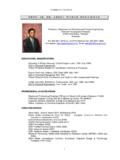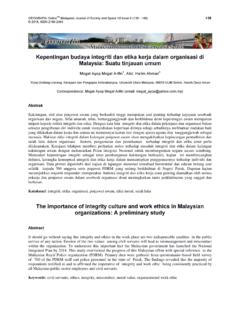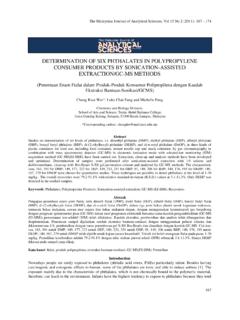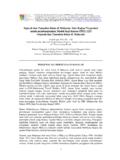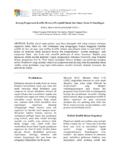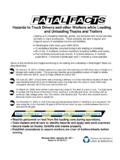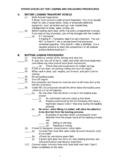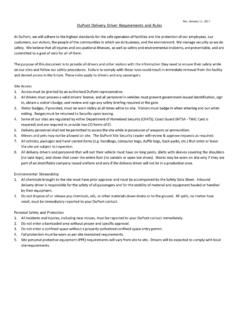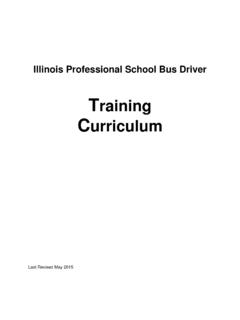Transcription of A SIMULATION STUDY OF WAREHOUSE LOADING …
1 Journal of Quality Measurement and Analysis JQMA 5(2) 2009, 45-56 Jurnal Pengukuran Kualiti dan Analisis A SIMULATION STUDY OF WAREHOUSE LOADING AND unloading SYSTEMS USING ARENA (Kajian Simulasi ke atas Sistem Pemuatan dan Pemunggahan Gudang Menggunakan ARENA) CHOONG-YEUN LIONG & CAREEN LOO ABSTRACT In a WAREHOUSE , all the processes in the LOADING and unloading systems are run simultaneously. In this paper, animated ARENA SIMULATION models for the LOADING and unloading systems in a WAREHOUSE are presented and discussed. The aim of the STUDY is to find a strategy that will optimise the residence time of any lorry in the WAREHOUSE . The warehouses of interest are those that deal with already packed as well products that need sealing. The processes in the unloading system are checking, unloading , arranging and sealing, and storage of products; whereas for the LOADING system , the processes are processing the delivery order, picking and sealing, LOADING , and checking the load on the lorry.
2 A SIMULATION model of the existing system was developed and run to further understand the state of the operations. Utilisation of workers and waiting times at the various processes were discussed and analysed to identify the bottleneck in the system . It was identified that the interarrival time of customers lorries; waiting time at the order picking, sealing and LOADING process; and the number of forklift are the contributing factors towards the performance of the LOADING system . The unloading system , which uses the company own lorry, has no bottleneck because the lorry is well scheduled. Four improvement models were developed and compared. It was found that, when other factors are relatively the same, by adding a forklift and a driver, the chosen model has not only overcome the overtime problem but also reduces the waiting time of the customers by almost two hours, by more than 65%.
3 Keywords: SIMULATION ; WAREHOUSE ; LOADING ; unloading ; ARENA ABSTRAK Kesemua proses sistem pemuatan dan pemunggahan di sesebuah gudang adalah dijalankan secara serentak. Dalam makalah ini, dipersembah dan dibincangkan model simulasi ARENA yang beranimasi bagi sistem pemunggahan dan pemuatan di sebuah gudang. Tujuan kajian ini adalah mencari suatu strategi yang akan mengoptimumkan masa dalam kawasan bagi mana-mana lori di gudang tersebut. Tumpuannya adalah kepada gudang yang melibatkan produk yang siap terbungkus dan yang memerlukan perekatan. Proses-proses dalam sistem pemunggahan adalah proses memeriksa, memunggah, menyusun dan merekat, dan menyimpan produk; manakala bagi sistem pemuatan pula proses yang terlibat adalah mengeluarkan senarai tempahan, menyusun dan merekat, memuatkan produk, dan memeriksa muatan dalam lori.
4 Suatu model simulasi sistem sedia ada telah dibangunkan dan dilarikan untuk lebih memahami keadaan operasinya. Hasil keputusan yang meliputi tahap penggunaan tenaga kerja dan masa menunggu dalam pelbagai proses dibincangkan dan dianalisis untuk mengenal pasti kesendatan dalam sistem. Dikenal pasti bahawa selang masa ketibaan lori pelanggan; proses penyusunan, perekatan dan pemuatan; dan bilangan trak angkat susun adalah faktor-faktor yang menyumbang kepada prestasi sistem pemuatan. Sistem pemunggahan tiada mengalami kesendatan kerana menggunakan lori syarikat itu sendiri dan terjadual dengan baik. Empat model simulasi penambahbaikan telah dibangunkan dan dibandingkan. Didapati bahawa, apabila faktor-faktor lain adalah terkawal, dengan menambahkan sebuah trak angkat susun dan pemandunya, sistem pilihan bukan sahaja berjaya menangani masalah kerja lebih masa yang dialami tetapi juga mengurangkan masa menunggu para pelanggan sebanyak hampir dua jam, iaitu lebih daripada 65%.
5 Kata kunci: simulasi; gudang; pemuatan; pemunggahan; ARENA Choong-Yeun Liong & Careen Loo 46 1. Introduction WAREHOUSE is an important distribution centre. Receiving and delivering are the interface of a WAREHOUSE for incoming and outgoing material flow. Incoming shipments are brought to the WAREHOUSE , unloaded at the receiving docks, and put into storage. Orders are picked from storage, prepared, and shipped to customers through docks by using van, lorry, truck and ship. The examples of receiving and delivering operations are the assignment of trucks to docks and the scheduling of LOADING and unloading activities (Gu et al. 2007). In this work, the processes in the LOADING (delivering) and unloading systems (receiving) are carried out simultaneously daily at the WAREHOUSE . The processes in the unloading system are the arrival of supplier s lorry, checking, unloading , packing, sealing and storage.
6 On the other hand, arrival of a customer s lorry, processing the delivery order, order picking, sealing, LOADING and checking are the processes undertaken in the LOADING system . Nowadays, SIMULATION studies are widely used for applications in engineering industry as a tool to increase the capacity of manufacturing and the profit of a company. SIMULATION studies are widely used in manufacturing, material handling, delivery, business processes, and transportation. Na et al. (2009) stated that SIMULATION techniques are widely used in the analysis of port and terminal planning process and container handling system . SIMULATION studies has not only assisted in understanding the details of the processes, but the graphical modelling tools and animated run like those in ARENA also ease the involvement of the management in the development and the decision making processes (Seila et al.)
7 2003). In this paper, a SIMULATION STUDY was conducted in order to overcome some of the problems at a WAREHOUSE in a detergent factory, especially the waiting times at the various processes. The lorry drivers were found to have to queue for a long time to carry out the LOADING processes, where on average, they have to wait for about 182 minutes to be serviced, and an average residence time of 294 minutes (nearly 5 hours). These long waiting and total times mean the drivers will lose the opportunity to serve any other distributor and workers at the WAREHOUSE have to work overtime. The management realised that the problem is due to lack of facilities and workers. The facilities at the WAREHOUSE include forklift, sealing machine, dock, pallet and computer. Besides that, the management also aims to minimise the total expenditure at the factory. Hence, a SIMULATION STUDY was proposed to model the LOADING and unloading systems in order to find a strategy that will optimise the residence time of any lorry in the WAREHOUSE and overcome the overtime problem.
8 2. Related Works WAREHOUSE stores factory product or goods from suppliers and then distribute to wholesalers or customers. According to Van den Berg (1996), topics such as planning and controlling in WAREHOUSE management have been studied by researchers in both the arts and the sciences. Nevertheless, a good basic theory for design methodology of WAREHOUSE is still lacking. In order to provide a characterisation of the WAREHOUSE , three different angles from which a WAREHOUSE may be viewed have to be considered: processes, resources, and organisation (Rouwenhorst et al. 2000). Products arriving at a WAREHOUSE will go through a number of steps called processes. Resources refer to all tools, equipment and personnel needed to operate a WAREHOUSE . Finally, organisation includes all aspects of planning and the control procedures used to run the WAREHOUSE system .
9 A product is defined as a type of goods, for example shampoo of a certain brand in the STUDY . An individual bottle is called an item and the combination of several items of several products requested by a customer is called a customer order. Rockwell ARENA is a SIMULATION and automation software from Rockwell Automation, A SIMULATION STUDY of WAREHOUSE LOADING and unloading systems using ARENA 47 Inc. It uses the SIMAN SIMULATION language as the underlying building block and the current version is version (ArenaSimulation 2009; ArenaWiki 2009). In ARENA, a SIMULATION model can be built by putting together predefined modules, which represents processes or logic. Connector lines are used to connect modules and designate the flow of entities. Statistical data, such as cycle time and waiting time are recorded and displayed automatically as reports by ARENA. ARENA has been widely used in simulating business processes and various kinds of discrete event operations.
10 Large firms that use ARENA include GM, UPS, IBM, Nike, XEROX, Lufthansa, Ford, Lucent and Sony (ArenaSolution 2009). ARENA is used in Na et al. (2009) to model and simulate the terminal operation processes which involve ship arrival, LOADING , unloading and other related discrete events. Tahar and Hussain (2000) use ARENA to model and simulate the seaport operations at the Malaysian Kelang port. Deshpande et al. (2007) use ARENA to model and analyse truckload terminal operations in order to experiment with alternative dock assignment scenarios. Greasley (2008) gives a good account on the usage of SIMULATION modelling in the manufacturing sector, and stresses that most are for the analysis of production planning and for control purposes. Greasley uses ARENA SIMULATION to investigate the effect of conveyor breakdowns on the performance of a continuous operations process.


